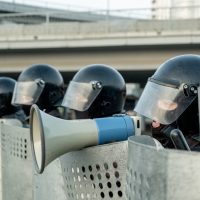Did LAPD or CHP Use Excessive Force During Heatwave Protests? Here’s How to Fight Back

Heatwave protests in California flooded the streets with people, and as these protests often do, they led to police presence in record time. Protests gather large crowds in cities like Los Angeles and San Diego, and even when crowd activity remains peaceful and focused on a message, it only takes one misinterpreted event to lead to police violence. This is why it’s so important for protesters to understand their rights and know when to call on excessive force attorneys to help them after an arrest.
At the Law Offices of Dale K. Galipo, we are passionate about protecting our clients’ civil rights and holding police accountable when they harm the people they are meant to serve. For decades, attorney Dale K. Galipo has used his trial skills to serve those whose civil rights have been violated. Find out how our excessive force law firm can help you by calling us at 818-347-3333.
What Counts as Excessive Force?
Under the Fourth Amendment, you are protected from unreasonable seizures by law enforcement. What’s considered reasonable is based on a number of factors, including the severity of the alleged offense and if you posed an immediate threat to yourself or anyone around you. In the context of protesting, for example, yelling a phrase or carrying a poster that the police don’t like isn’t an offense, much less one that warrants tear gas or physical force.
California state law outlines limitations for the use of physical force by police officers, noting that every decision to use physical force must be evaluated carefully in a way that reflects the gravity of an officer’s authority. If a police officer has reasonable cause to believe that you committed a public offense, they can use objectively reasonable force. Essentially, this means that the force must be equal to the severity of the threat. When an officer uses more physical power than is necessary to maintain control of a situation, they may be guilty of using excessive force.
Common Forms of Excessive Force at Protests
As excessive force attorneys, we’ve seen nearly every type of force be used against people exercising their right to protest. Examples of excessive force during protests include:
- Striking protesters with batons without justification
- Firing rubber bullets and bean bag rounds into peaceful crowds
- Using tear gas or pepper spray in confined areas
- Kettling, or corralling protesters into a confined space
- Shoving, tackling, or knocking down protesters who are not resisting or posing a threat
Unique Dangers During Summer Protests
Recent protests have left protesters exposed to extreme heat—which isn’t an issue as long as they have access to water and can leave as they choose. But when protesters are subjected to kettling and are kept in a small area without access to medical care or water, they are at serious risk of developing heat-related illness. The use of chemical agents are also particularly dangerous in this weather, as these agents can worsen respiratory problems that are caused or exacerbated by hot weather. Finally, police departments that bring in mass amounts of protesters are often unprepared to meet the actual needs of the people they’ve arrested—and that’s even more dangerous when you’ve picked up people who are likely dehydrated and at risk of heat illness.
What to Do As a Victim of Excessive Force
If you’ve been targeted by police officers during a protest, you have legal options. From the very beginning, document everything you can. Many confrontations with police are caught from multiple angles on smartphones, so keep copies of any videos you find—and if possible, take your own video footage to protect yourself and not let them control the narrative. Seek medical attention as soon as you are able to. This allows you to document any injuries or illnesses caused by your interaction with the police.
After you have been released from police custody, you can discuss your options with an excessive force lawyer. You may file a complaint with the agency directly, and if they do not resolve the issue in an appropriate manner, you can move forward with suing them. However, the timeline to sue a government agency is quite short in California. Act quickly to protect your rights.
Discuss Your Options With the Law Offices of Dale K. Galipo
Protesting is your right. If your efforts to exercise your rights have left you battered and traumatized, let’s talk about your next steps. Give us a call at 818-347-3333 or send us a message online to discuss your case.
